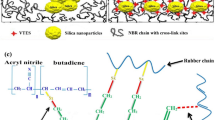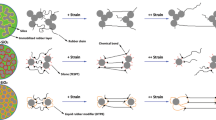Abstract
The microdispersion of silica in filled elastomer vulcanisates was evaluated by transmission electron microscopy (TEM)—network visualisation analysis. In this study, the silica is modified with a wide range of coupling and non-coupling silanes. The silica-filled elastomer samples were microtomed using a glass knife. The resulting TEM micrographs were interpreted and characterised based on aggregates with a cross-sectional area larger than 100 nm2. The study showed that silica surface modification has reduced the silica aggregate size by approximately 30–40% compared to an untreated silica-filled elastomer vulcanisate. The TEM micrographs showed evidence of coupling between silica and the elastomer phase and demonstrated a good estimation of silica microdispersion in the elastomer phase. This study has shown that the presence of different surface functionalities has an effect on the silica microdispersion.













Similar content being viewed by others
References
Wang MJ (1998) Effect of polymer–filler and filler–filler interaction on dynamic properties of filled vulcanisates. Rubb Chem Technol 71:520–589
Li YB, Wang MJ, Zhang T, Zhang F, Fu X (1994) Study on dispersion morphology of silica in rubber. Rubb Chem Technol 67:693–699
Julve D, Menendez M, Perez J, Ramos J (2011) Microdispersion of silica in tire tread compounds above the percolation threshold by TEM image measurements. Rubb Chem Technol 84:74–87
Le HH, Ilisch S, Radusch HJ (2009) Characterisation of the effect of the filler dispersion on the stress relaxation behaviour of carbon black filled rubber composites. Polymer 50:2294–2303
Le HH, Tiwari M, Ilish S, Radusch HJ (2005) Effect of molecular structure on carbon black dispersion in rubber compounds. Kaut Gumm Kunst 58(11):575–580
ASTM D2663-14 (2014) Standard test methods for carbon black—dispersion in rubber. ASTM International, West Conshohocken
Otto S, Randl O, Goncalves O, Cantaloube B (2005) New reference value for the description of filler dispersion with the dispergrader 1000 NT. Kaut Gumm Kunst 58:390–393
ASTM D7723-17 (2018) Standard Test method for rubber property-macro-dispersion fillers in compounds. ASTM International, West Conshohocken
Putman MC, Putman JB (2007) High resolution reflected light microscopy to determine filler micro-dispersion. Paper 103 Presented at Fall Technical Meeting of the Rubber Division of American Chemical Society, October 17, Cleveland, Ohio
Bielinski D, Slusarski L, Dobrowolski O, Dryzek E (2004) Studies of filler agglomeration by atomic force microscopy and positron annihilation spectroscopy. Part 1: silica filled compounds. Kaut Gumm Kunst 11:579–586
Wang CC, Wu SH, Donnet JB, Wang TK (2006) Microdispersion of carbon blacks in rubber. Kaut Gumm Kunst 59:466–472
Chapman AV, Cook S, Davies RT, Patel J, Clark JL (2009) Microdispersion of silica in tire tread compounds based on epoxidized natural rubber. Paper 73 Presented at the Fall Technical Meeting of the Rubber Division of the American Chemical Society, 12–15 October 2009, Pittsburg
Sarkawi SS, Dierkes WK, Noordermeer JMW (2014) Elucidation of filler-to-filler and filler-to-rubber interactions in silica-reinforced natural rubber by TEM network. Eur Polym J 54:118–127
Sarkawi SS, Kaewsakul W, Sahakaro K, Dierkes WK, Noordermeer JMW (2015) A Review on reinforcement of natural rubber by silica fillers for use in low-rolling resistance tyres. J Rubb Res 18(4):203–233
Sarkawi SS, Dierkes WK, Noordermeer JMW (2015) Morphology of silica-reinforced natural rubber: the effect of silane coupling agent. Rubb Chem Technol 88(3):359–372
Sarkawi SS, Dierkes WK, Noordermeer JMW (2014) Effect of a silane coupling agent on the morphology of silica reinforced natural rubber. Kaut Gumm Kunst 3:29–33
Ngeow YW, Chapman AV, Heng JYY, Williams DR (2016) Characterization of silica modified with silanes using thermogravimetric analysis combined with infrared detection. Paper 67 presented at the Fall 190th Technical Meeting of the Rubber Division of the American Chemical Society, Pittsburgh, PA
Ngeow YW, Chapman AV, Heng JYY, Williams DR (2018) Characterization of silica modified with silanes by using thermogravimetric analysis combined with infrared detection. Rubb Chem Technol. https://doi.org/10.5254/rct.18.82626
Martin P, Brown P, Chapman AV, Cook S (2015) Silica-reinforced epoxidised natural rubber tire treads—performance and durability. Rubb Chem Technol 88:390–411
Castellano M, Conzatti L, Turturro A, Costa G, Busca G (2007) Influence of the silane modifiers on the surface thermodynamic characteristics and dispersion of the silica into elastomer compounds. J Phys Chem B 111:4495–4502
Ladouce-Stelandre L, Bomal Y, Flandin L, Labarre D (2003) Dynamic mechanical properties of precipitated silica filled rubber: influence of morphology and coupling agent. Rubb Chem Technol 76:145–159
Ladouce-Stelandre L, Bomal Y, Flandin L, Labarre D (2000) Dynamic mechanical properties of precipitated silica filled rubber: influence of morphology and coupling agent. Paper 33 presented at the Spring Technical Meeting of the Rubber Division of the American Chemical Society, Dallas
Hidehiko D, Shin H (2007) Locating a silane coupling agent in silica-filled rubber composites by EFTEM. Langmuir 23:12344–12349
Ngeow YW, Heng JYY, Williams DR, Chapman AV (2016) Investigating the effect of silica modification on rubber vulcanisates. In: International rubber conference, Kitakyushu
Blume A (2011) Kinetics of the silica–silane reaction. Kaut Gumm Kunst 64:38–43
Lin CJ, Hergenrother WL, Hilton AS (2002) Mooney viscosity stability and polymer filler interactions in silica filled rubbers. Rubb Chem Technol 75:215–245
Robertson CG, Lin CJ, Bogoslovov RB, Rackaitis M, Sadhukhan P, Quinn JD, Roland CM (2011) Flocculation, reinforcement, and glass transition effects in silica-filled styrene-butadiene rubber. Rubb. Chem. Technol. 84:507–519
Lin CJ, Hergenrother WL, Alexanian E, Bohm GGA (2002) On the filler flocculation in silica-filled rubbers Part I. quantifying and tracking the filler flocculation and polymer–filler interactions in the unvulcanized rubber compounds. Rubb Chem Technol 75:865–890
Scurati A, Lin CJ (2006) The hysteresis temperature and strain dependences in filled rubbers. Rubb Chem Technol 79:170–197
Mahtabani A, Alimardani M, Razzaghi-Kashani M (2017) Further evidence of filler–filler mechanical engagement in rubber compounds filled with silica treated by long chain silane. Rubb Chem Technol 90:508–520
Sato M, Dierkes WK, Blume A (2017) Silane-polymer reaction: investigation of the silane–polymer reaction in a model system. Tire Technol Int 2017:66–70
Sato M (2018) Reinforcing mechanisms of silica/sulfide-silane vs. mercapto-silane filled tire tread compounds. PhD Thesis, The Netherlands: University of Twente
Author information
Authors and Affiliations
Corresponding author
Additional information
Publisher's Note
Springer Nature remains neutral with regard to jurisdictional claims in published maps and institutional affiliations.
Rights and permissions
About this article
Cite this article
Ngeow, Y.W., Heng, J.Y.Y., Williams, D.R. et al. TEM observation of silane coupling agent in silica-filled rubber tyre compound. J Rubber Res 22, 1–12 (2019). https://doi.org/10.1007/s42464-019-00005-y
Received:
Accepted:
Published:
Issue Date:
DOI: https://doi.org/10.1007/s42464-019-00005-y




